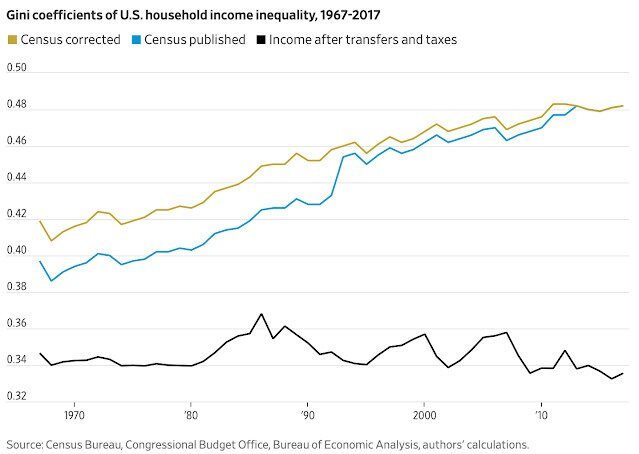If your game is to argue for more taxes and transfers to fix income inequality, that is a dandy subterfuge as no amount of taxing and transferring can ever improve the measured problem!
Now facts are facts, and this one has a good progressive interpretation: But for our sharply progressive tax system and benefits, untrammeled capitalism would have led to sharply increased inequality. The numbers don't argue for more redistribution, but they are consistent with a narrative that only our current large redistribution saved us from the top two lines.
Gramm and Early offer a sentence on this worth pausing to think about:
As government transfer payments to low-income households exploded, their labor-force participation collapsed and the percentage of income in the bottom quintile coming from government payments rose above 90%.A major force behind the pre-tax and pre-transfer numbers is the fall in labor force participation among people experiencing low income. It is not entirely impossible that some causality runs from larger means-tested benefits -- earn a dollar lose a dollar worth of benefits -- to withdrawing from the workforce, rather than the other way around.
The second clause is enlightening. People experiencing income in the bottom fifth of the US population get 90% of their income from the government.
There is lots more to unpack in distributional numbers of course. Household composition and demographics have changed, consumption inequality matters not income inequality, the relative prices of things people buy have diverged -- goods cheaper, services more expensive, cities and states like CA much more expensive, and so on. But that so much debate is based on so transparently flawed a number is worth remembering.
It's not easy by the way. As the tax code is deliberately complicated, so is the nature of transfers.
Census Bureau income data fail to count two-thirds of all government transfer payments — including Medicare, Medicaid, food stamps and some 100 other government transfer payments — as income to the recipients.
These include the earned-income tax credit, whose beneficiaries get a check from the Treasury; food stamps, which let beneficiaries buy food with government issued debit cards; and numerous other programs in which government pays for the benefits directly.I have not dug into the methods. How do you count services provided like housing, medical care, VA care, etc.?
Handy numbers, in addition to the 90% above:
In 2017, federal, state and local governments redistributed $2.8 trillion, or 22% of the nation's earned household income.
Americans pay $4.4 trillion a year in federal, state and local taxes. Households in the top two earned-income quintiles pay 82% of the tax bill




Reader Comments
to our Newsletter